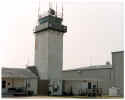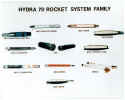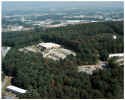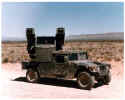1983
FY 83 The SHORAD C2 was designated as a major Army system.
FY 83 The Army Missile Laboratory won this year's Award of Excellence from DA for the fifth consecutive year. In addition, MICOM received three other prestigious Army Research and Development Achievement Awards this year.
FY 83 The installation's Military Police began unannounced searches of vehicles entering and leaving Redstone Arsenal. Although the primary purpose of these inspections was to detect the transport or use of drugs, the program coincided with other Army programs designed to curb drunken driving and thefts of government property.
FY 83 A settlement was reached in the DDT contamination lawsuit (U.S. Army v. Olin Chemical Corporation), which had been filed in December 80. Olin agreed to pay cash settlements to the plaintiffs of the area around Triana, Alabama. It would also conduct a study of the contaminated area in the Wheeler Reservoir, design a DDT mitigation program, install control devices as necessary, and monitor and maintain these devices under the supervision of a review panel set up by the Department of Justice.
FY 83 As a result of the Procurement and Production Directorate's initiative in promoting competition, MICOM received a commendatory finding from the DARCOM Inspector General. MICOM's established procedures were also offered for adoption at DARCOM's other major subordinate commands (MSCs).
FY 83 As part of its evaluation of candidates for the interim lightweight air defense system (I-LADS), the Army Air Defense Artillery Center found that the STINGER, augmented by a gun, was consistently the most effective system. These results convinced the center to change its requirements for LADS from a 40mm gun to a generic system, allowing a STINGER/gun hybrid to compete as the ultimate LADS.
FY 83 In an effort to capitalize on the effectiveness of a hybrid STINGER/gun system while achieving the lightweight advantages desired in the LADS, the Army Missile Laboratory began planning the development of the SETTER. The proposed system was a lightweight air defense test bed demonstration unit incorporating multiple target acquisition and fire control sensors with both guided and unguided munitions. In conjunction with TACOM, the SETTER was being developed for mounting on the roof of the high mobility, multipurpose, wheeled vehicle (HMMWV). The system would feature eight STINGER missiles mounted on four pods and would carry Single Penetrator Kinetic Energy (SPIKE) hypervelocity rockets developed by AML's Systems Simulation and Development Directorate.
FY 83 The Federal Aviation Administration (FAA) selected Redstone Army Airfield to be a flight service station sub-facility, based on the amount of its air traffic and hours of operation.

FY 83 The Flight Operations Division turned over its YC-7 Caribou (No. 57-3080) aircraft to the aviation museum at Fort Rucker, Alabama. Put into service in 1957, this particular plane was the second Caribou in Vietnam. No. 57-3080 also served as the flagship for the president of South Vietnam. The aircraft flew about 10,000 hours in its 26 years of Army service.
FY 83 AMC tasked MICOM to develop a comprehensive plan to ensure the commonality of missiles and launcher hardware for STINGER derivations, including the ATAS, SERGEANT YORK, Pedestal Mounted STINGER (PMS), and Product Improved VULCAN Air Defense System (PIVADS) Hybrid.
January 83 Worldwide HAWK readiness attained its highest level since the system was first fielded in 1960.
17 January 83 The RATTLER Management Office (Provisional) was abolished effective this date for lack of official Army approval and funding. The discontinued office's RATTLER tasks were assigned to ASCO, while its Tank Breaker tasks were given to the System Development Office.
1 March 83 MICOM Headquarters was reorganized effective this date. The offices of the Commanding General, DCG for Research and Development, and the DCG for Readiness were abolished as separate organizational elements and transferred in place to the newly established Command Group. At that time, the Office of the Deputy Chief of Staff (DCS) was abolished, while the Office of the Secretary to the General Staff (SGS) was established. In addition, the Protocol, Historical, and Command Support Services offices were reassigned as division-level elements of the SGS.
10 March 83 The JTACMS Project Office (Provisional) was established to serve as the directing agency for a joint Army-Air Force program to develop a common tactical missile system. The Army acted as the executive service, while the Air Force was the participating service.
14 March 83 DARCOM approved the popular name HYDRA 70 for the improved 2.75-Inch rocket system. This action served the immediate purpose of distinguishing the MICOM-managed HYDRA 70 rocket from the standard 2.75-Inch rocket materiel managed by ARRCOM, Rock Island, Illinois.
14 March 83 MICOM initially announced that the results of a cost comparison study revealed that the government would save an estimated $1.8 million over a 5-year period by continuing to perform the installation's support functions with federal employees. The following day, however, auditors examining the calculations used in the cost comparison process discovered that one contractor's proposal was actually $986,867 less than the government's bid.
16 March 83 MICOM awarded a conditional contract to the California-based firm of Holmes and Narver, Inc./Morrison-Knudsen Company, the low bidder, to provide arsenal support services for a 5-year period beginning 1 October 83.
28 March 83 The BFVS reached IOC with the first deployment to Fort Hood, Texas.
30 March 83 The American Federation of Government Employees (AFGE), Local 1858, the union that represented most MICOM civilian workers, appealed the decision to award a contract for the arsenal's support services. The union contended that the Army incorrectly interpreted federal law when it applied inflation rates in computing certain government labor costs over the 5-year length of the contract.
31 March 83 The first MLRS tactical battery was fielded at Fort Riley, Kansas, meeting the scheduled IOC date.
14 April 83 The Secretary of the Army approved full-scale production of the MLRS.
18 April 83 The Secretary of Defense announced that President Ronald Reagan had approved and sent to the U.S. Senate for confirmation the nomination of MG Robert L. Moore for promotion to lieutenant general. Commander of MICOM since July 80, General Moore was scheduled to become the DARCOM DCG for Research, Development, and Acquisition. The Senate confirmed General Moore's promotion in May 83.
21 April 83 The Secretary of the Army approved type classification standard for MLRS major equipment.
25 April 83 The DCG for Readiness title was changed to DCG for Readiness and Procurement.
25 April 83 A DARCOM-appointed board, consisting of three MICOM managers and two alternates with no previous involvement in MICOM's commercial activities program, reviewed the decision to contract out Redstone Arsenal's base support activities. It subsequently agreed with the union's contention that the Army incorrectly interpreted federal law when it applied inflation rates in computing certain government labor costs over the 5-year length of the contract. Consequently, the board reversed the decision to award a contract for the arsenal's support services. Recalculation of the labor rates based on the board's decision showed the cost of continuing with government workers to be $106,583 less.

27 April 83 The United States and the Federal Republic of Germany signed an MOU for dual production of the Basic STINGER and STINGER-passive optical seeker technique (POST) weapon systems. A STINGER Dual Production Support Office was established at Koblenz, Germany.
May 83 The U.S. Army Environmental Hygiene Agency began a year-long air pollution study at Redstone Arsenal, the first to be conducted on the installation. Background data on air quality was collected to determine what effect steam generation activities had on air quality in the area.
May 83 Installation gate manning duties at Redstone Arsenal were transferred to DA civilian guards because of severe manpower shortages within the 291st Military Police Company.
3 May 83 The new Officers Club opened on Redstone Arsenal. Located on a knoll overlooking the Redstone Golf Course, the $3.9 million facility featured modern aspects in decor and design as well as computerized dining and bar equipment.

5 May 83 The first TOW 2 missile was delivered to the Army at a ceremony held at the Hughes Aircraft Company plant in Tucson, Arizona.
9 May 83 The contractor appealed the Army's decision not to award a commercial contract for Redstone Arsenal base support services.
June 83 Switzerland expressed an interest in joining the European/American STINGER dual production program. The member nations approved Switzerland's participation, but the Swiss made no commitment during this year.
1 June 83 DOD issued a new regulation-Defense Acquisition Regulation, Supplement No. 6 (DARS-6)-which prescribed uniform policies, procedures, and report formats for the DOD Replenishment Parts Breakout Program.
6 June 83 The Army Systems Acquisition Review Council (ASARC) decision on STINGER-POST production was to enter production with a concurrent reprogrammable microprocessor (RMP) configuration development, which would be delivered at the completion of production transition. The RMP would expand the functional control of microprocessors in the electronics and permit the reprogramming of STINGER system logic through an externally accessible program module.
10 June 83 After reviewing appeals by the contractor and by a Redstone Arsenal employee, the appeal board again ruled that it was more economical to continue performing the installation's support services with government workers. In fact, the board found that by continuing to provide these services in-house, the government would save more than $1.9 million over the cost of contracting these services over a 5-year period.
15 June 83 A letter contract for the FY 1983 13-month definition phase of the JATM, let through the PATRIOT Project Office, was signed on this date.
24 June 83 Holmes and Narver/Morrison-Knudsen filed protests with the Government Accounting Office (GAO) concerning the Contract Appeals Board's decision in favor of civil service in-house performance of certain installation housekeeping activities. On 17 November 83, GAO decided that MICOM must recalculate the in-house cost proposal. Due to this action, a reduction in force to bring RASA into its "streamlined mode" of operation was postponed pending the results of the GAO investigation. The "streamlined mode," which formed the basis for the government's in-house bid, was to have gone into effect on 1 October 83. After classifying the method of cost computation, MICOM resubmitted its in-house proposal. At the end of FY 84, a final decision had not been reached on whether certain base support functions would remain in-house or would be contracted out.
July 83 The U.S. Senate approved the transfer of 61 acres of Redstone Arsenal land to the Alabama Space and Rocket Center. The land, declared surplus by a federal property review board, would provide the center with direct access to the planned interstate spur between I-65 and the city of Huntsville. It would also ensure access to the arsenal for the transporting of large missiles and rockets exhibited at the center.
July 83 Building Technology, Incorporated, a contractor from Silver Spring, Maryland, released a draft report containing the results of a historic properties survey of the buildings and structures on Redstone Arsenal. The firm was under contract to DARCOM to identify any buildings or structures on DARCOM installations that were worthy of protection and preservation. The contractor also recommended any property that might be eligible for nomination to the National Register of Historic Places. The draft survey report listed two Army buildings-Fire Station #3 and the Harris residence-as Category III (properties of minor importance) and several Marshall Space Flight Center structures as Category II (properties of importance).
July 83 Initial deployment of the TOW 2 was made to the U.S. Army Infantry School at Fort Benning, Georgia.
25 July 83 Following news stories about instances of overcharging for Air Force and Navy spare parts, the Secretary of Defense announced a 10-point program aimed at eliminating price abuses in the future and recovering unjustified payments already made.
26 July 83 The PATRIOT Project Office was reassigned from DARCOM to MICOM effective this date.
26 July 83 MG Jerry Max Bunyard became Commanding General of MICOM. Formerly project manager for the PATRIOT, he had been reassigned to MICOM Headquarters on 18 July 83.

27 July 83 Initiation of STINGER-POST production was approved on this date pending resolution of the RMP funding issues.
August 83 The MOU between MICOM, the U.S. Army Aviation Research and Development Command (AVRADCOM), and the U.S. Army Troop Support and Aviation Materiel Readiness Command (TSARCOM) concerning the MLMS was completed during the month. The MLMS was actually a two-missile concept: one missile to be developed for an air-to-air role and the other for an air defense suppression role. Because there were different operational capability dates for the two concepts, this MOU applied only to the air-to-air missile. The MOU defined each command's respective roles and responsibilities in the ATAS program.
11 August 83 DARCOM directed that the title of the DCG for Readiness and Procurement be changed to DCG for Procurement and Readiness.
14 August 83 The JATM Program Office, established provisionally on 15 June 82, became permanent effective this date.
29 August 83 To assure essential improvements in all areas of the acquisition process, the Secretary of Defense established a 25-point program which expanded the initial 10-point program to include additional efforts by all functional disciplines involved in the acquisition process.
29 August 83 As a result of the Secretary of Defense directives issued on this date, MICOM's repair parts procurement program received increased management attention. The MICOM Assistant Deputy for Readiness subsequently created the Ad Hoc Committee for Spare Parts Acquisition on 14 October 83.
September 83 Morton Thiokol began a $7.5 million expansion program in the old "Rohm and Haas area" off Line Road with the construction of a new propellant mixer building. The contractor also began renovating some of the World War II-era structures that had once made up lines 3 and 4 of the Ordnance Corps' chemical munitions loading and assembly operations.
September 83 The first BFVS was deployed to USAREUR.
September 83 A joint evaluation of the unsolicited proposal submitted by General Dynamics and Bell Helicopter Textron, Incorporated, for engineering development of the air-to-air MLMS culminated in a decision to accept the contractors' proposal but only with some technical modifications.
1 September 83 The first outside continental United States (OCONUS) MLRS battery was fielded to the 8th ID in Germany.
1 September 83 The Missile Command awarded General Dynamics a low-rate initial production transition contract for the STINGER-POST.
2 September 83 NATO interoperability tests using the HELLFIRE missile system were successfully conducted in Norway. This was significant because these tests showed that the HELLFIRE was compatible with other NATO platforms and designators. They also illustrated that HELLFIRE integration into other launch aircraft could be accomplished quickly and easily. It was also the second time that the HELLFIRE system was tested on foreign soil in cooperation with NATO and other allied powers.
6 September 83 A successful IOC for the STINGER weapon system in Korea was achieved.
9 September 83 The MICOM Commander approved a full release for the TOW 2.
19 September 83 Under a separate MOU signed on this date, Germany acted as the licensee for a consortium of NATO nations interested in some kind of joint partnership for producing the STINGER and STINGER-POST. The nations included in the partnership were the Netherlands, Belgium, Greece, Turkey, and Italy. A separate STINGER Project Group MOU with these countries was signed because Germany had agreed that STINGER hardware could be sold or transferred only to NATO countries with which it had a separate MOU.
21 September 83 Boeing Aerospace Company presented a modified, unsolicited proposal to the Army Development and Employment Agency for an AVENGER prototype demonstration in April 84. The AVENGER was being studied as a possible candidate for the 9th ID's need for a HMMWV-mounted STINGER. The prototype would consist of four ATAS launchers turret-mounted on the back of a HMMWV.

24 September 83 Congress approved the Towed CHAPARRAL configuration.
October 83 A new fast food restaurant, the first club-owned facility at a DOD activity, was built to improve the quality of life at the arsenal and to create income for the NCO and Enlisted clubs.
October 83 The MICOM Army Missile Laboratory initiated a program to demonstrate the advantages of integrating the Navy's RIM-7M SPARROW missile into the HAWK system to provide a SPARROW/HAWK missile mix as a potential first step in HAWK evolution to meet the Evolutionary Surface-to-Air Missile System (ESAMS) requirements.
A joint effort of MICOM, the Marine Corps Development and Education Command, and the Naval Air Systems Command, this experimental weapon was intended to complement the HAWK missile system. More mobile and transportable, the SPARROW/HAWK system could be fitted with either nine SEA SPARROW missiles or the usual three HAWK missiles. In either mode the weapon would be capable of attacking multiple targets using the low-altitude simultaneous HAWK engagement (LASHE) guidance.
October 83 The fielding of STINGER under combat conditions occurred during the U.S. airborne assault on Grenada. The deployment of 27 STINGER teams against Cuban and local forces on the Caribbean island provided a valuable learning experience for both the paratroopers and the chain of command. Questions about the system's manportability as well as other needs were raised by the assault.
October 83 The IOC date was met with the first deployment of the TOW 2 to USAREUR.
7 October 83 DA directed the total termination of the VIPER program, which had been a possible replacement for the M72 Light Antitank Weapon (LAW).
11 October 83 The VCSA restored HYDRA 70 requirements to the FY 1985-89 Program Objective Memorandum after the Fort Rucker Army Aviation Center, with TRADOC support, advised DA that the HYDRA 70 rocket was a vital weapon in specific scenarios. The program's cancellation had been expected to have serious tactical and doctrinal impacts.
27 October 83 The U.S. Army Air Defense Board completed an evaluation of the U.S. Army Armament Research and Development Center (ARDC) air defense gun/missile experiment known as air defense gun missile experiment (ADGILE). The prototype of the hybrid system consisted of a 25mm GAU-12/U cannon and an engineering ATAS launcher. The experiment clearly demonstrated the feasibility of an integrated STINGER/gun hybrid system.
November 83 TMDE's 95th Service Company was redesignated the 95th Maintenance Company.
1 November 83 A new fast food facility-Biscuits and Burgers-opened on Redstone Arsenal.
15 November 83 The JATM System Project Office (Provisional) was established at MICOM effective this date, while the JATM Program Office, formed in July 82, was disestablished.
December 83 As part of its study of DDT pollution on Redstone Arsenal, Olin Chemical Company tested the ground water supplies on the installation for possible DDT contamination. Researchers drew 10 ground water samples-5 from monitoring wells in the area around the old DDT manufacturing site and 5 others from public drinking water supply wells in communities around the arsenal. Study results released during this month indicated that for the most part less than 0.1 part per billion of DDT was found in the samples, indicating no ground water contamination problem. Nevertheless, the installation's Facilities Engineering began a ground water assessment program to evaluate the wide variation in ground water wells used in monitoring the DDT hazardous waste soils landfill area.
5 December 83 The United States, France, Germany, and the United Kingdom signed an MOU supplement to formally establish a TGW development program.
12 December 83 The VIPER Project Office was redesignated the Advanced Manportable Weapon System (AMWS) Project Office (Provisional). Approval of the organization's charter was delayed pending a decision on the AAWS-M program. The renamed office was responsible for residual VIPER activities as well as two other possible M72 replacements: the AT-4 Swedish Recoilless Rifle and M72E4 product improvement programs.
13 December 83 The last NIKE HERCULES Radar and Computer Repairman class at MMCS graduated. The 4 U.S. Army and 2 Taiwan students completing the class brought to 4088 the total number trained in HERCULES courses over the past 25 years. The only U.S. Army NIKE HERCULES missiles in Europe were being deactivated, although some allied nations planned to use the system at least through the end of the decade.
Redstone Arsenal Era:
Intro,
1980,
1981,
1982,
1983,
1984,
1985,
1986,
1987,
1988,
1989
